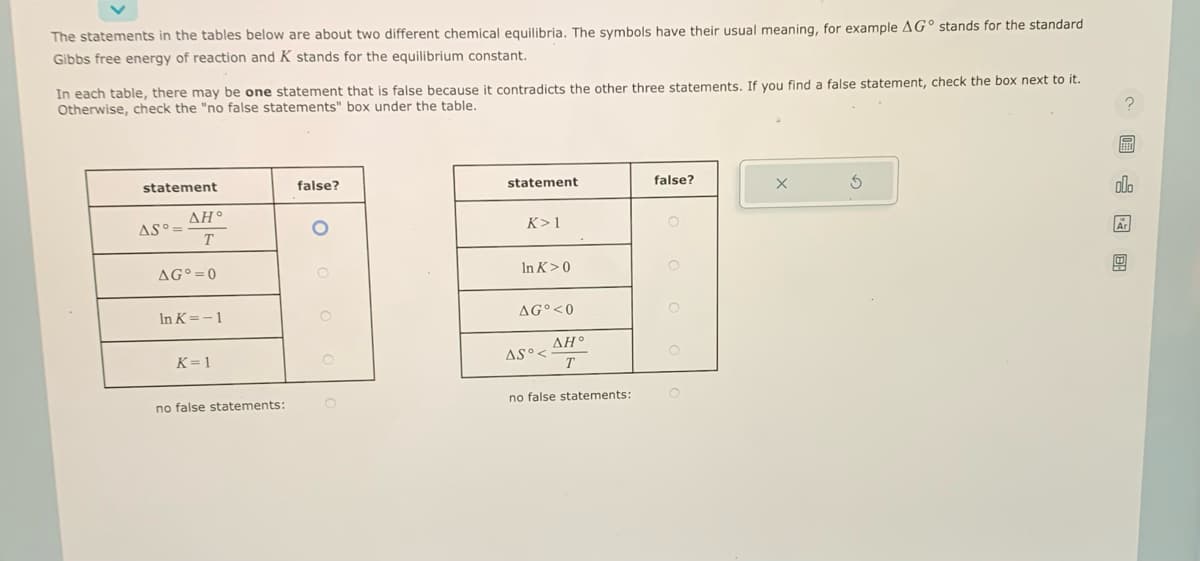The statements in the tables below are about two different chemical equilibria. The symbols have their usual meaning, for example AG stands for the standard Gibbs free energy of reaction and K stands for the equilibrium constant. In each table, there may be one statement that is false because it contradicts the other three statements. If you find a false statement, check the box next to it. Otherwise, check the "no false statements" box under the table. statement AS°= AH° T AG=0 In K= -1 K=1 no false statements: false? O statement K> 1 In K>0 AGO <0 AS°< AH° T no false statements: false? O O X 5
The statements in the tables below are about two different chemical equilibria. The symbols have their usual meaning, for example AG stands for the standard Gibbs free energy of reaction and K stands for the equilibrium constant. In each table, there may be one statement that is false because it contradicts the other three statements. If you find a false statement, check the box next to it. Otherwise, check the "no false statements" box under the table. statement AS°= AH° T AG=0 In K= -1 K=1 no false statements: false? O statement K> 1 In K>0 AGO <0 AS°< AH° T no false statements: false? O O X 5
Chemistry: An Atoms First Approach
2nd Edition
ISBN:9781305079243
Author:Steven S. Zumdahl, Susan A. Zumdahl
Publisher:Steven S. Zumdahl, Susan A. Zumdahl
Chapter16: Spontaneity, Entropy, And Free Energy
Section: Chapter Questions
Problem 5ALQ
Related questions
Question
Review question 9

Transcribed Image Text:The statements in the tables below are about two different chemical equilibria. The symbols have their usual meaning, for example AG stands for the standard
Gibbs free energy of reaction and K stands for the equilibrium constant.
In each table, there may be one statement that is false because it contradicts the other three statements. If you find a false statement, check the box next to it.
Otherwise, check the "no false statements" box under the table.
statement
AS°=
AH°
T
AG=0
In K= -1
K=1
no false statements:
false?
statement
K> 1
In K>0
AGO <0
AS°<
AH°
T
no false statements:
false?
O
O
X
5
? 图
EFEN
olo
Ar
Expert Solution
This question has been solved!
Explore an expertly crafted, step-by-step solution for a thorough understanding of key concepts.
This is a popular solution!
Trending now
This is a popular solution!
Step by step
Solved in 3 steps with 3 images

Knowledge Booster
Learn more about
Need a deep-dive on the concept behind this application? Look no further. Learn more about this topic, chemistry and related others by exploring similar questions and additional content below.Recommended textbooks for you

Chemistry: An Atoms First Approach
Chemistry
ISBN:
9781305079243
Author:
Steven S. Zumdahl, Susan A. Zumdahl
Publisher:
Cengage Learning

Chemistry
Chemistry
ISBN:
9781305957404
Author:
Steven S. Zumdahl, Susan A. Zumdahl, Donald J. DeCoste
Publisher:
Cengage Learning


Chemistry: An Atoms First Approach
Chemistry
ISBN:
9781305079243
Author:
Steven S. Zumdahl, Susan A. Zumdahl
Publisher:
Cengage Learning

Chemistry
Chemistry
ISBN:
9781305957404
Author:
Steven S. Zumdahl, Susan A. Zumdahl, Donald J. DeCoste
Publisher:
Cengage Learning


Chemistry: The Molecular Science
Chemistry
ISBN:
9781285199047
Author:
John W. Moore, Conrad L. Stanitski
Publisher:
Cengage Learning

Introductory Chemistry: A Foundation
Chemistry
ISBN:
9781337399425
Author:
Steven S. Zumdahl, Donald J. DeCoste
Publisher:
Cengage Learning

Chemistry: Principles and Practice
Chemistry
ISBN:
9780534420123
Author:
Daniel L. Reger, Scott R. Goode, David W. Ball, Edward Mercer
Publisher:
Cengage Learning